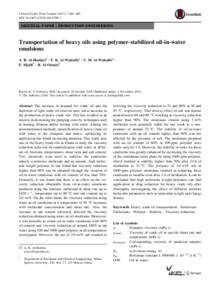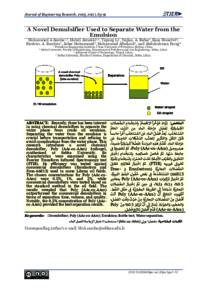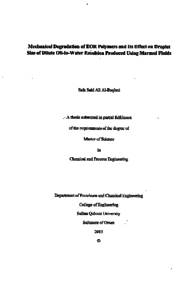Document
Transportation of heavy oils using polymer-stabilized oil-in-water emulsions.
Identifier
DOI: 10.1007/s13202-016-0298-7
Source
Journal of Petroleum Exploration and Production Technology. v. 7, 3, p. 881-890
Contributors
Country
Germany.
Publisher
Springer Verlag.
Gregorian
2017-09-01
Language
English
Subject
English abstract
The increase in demand for crude oil and the depletion of light crude oil reserves have led to increase in the production of heavy crude oils. This has resulted in an interest in decreasing the pumping costs by techniques such as heating, dilution and/or mixing with water. Among the aforementioned methods, emulsification of heavy crude oil with water is the cheapest, and hence, optimizing its application has found increasing attention. This study uses one of the heavy crude oils in Oman to study the viscosity reduction achieved by emulsification with water at different oil fractions, temperatures, shear rates and salt content. Two chemicals were used to stabilize the emulsions, namely a nonionic surfactant and an anionic, high molecular weight polymer. It was found that viscosity reduction higher than 90% can be obtained through the creation of oil-in-water emulsions with oil content of less than 70%. Generally, it was found that there is no effect on the viscosity reduction obtainable from oil-in-water emulsions produced using the nonionic surfactant at shear rate up to 1620 s−1, temperature up to 80 °C and salt content up to 2.0 wt%. On the other hand, the viscosity reduction using water-in-oil emulsions at a temperature of 30 °C increases with surfactant concentration and shear rate. Also, the increase in salt content adversely affected the viscosity reduction obtained using water-in-oil emulsions. Moreover, it was possible to create oil-in-water emulsions with 60% oil content and viscosity reduction of around 100% in tap water using 100 and 1000 ppm polymer at all temperatures investigated. However, the use of 2.0 wt% salt resulted in lowering the viscosity reduction to 53 and 80% at 30 and 45 °C, respectively. This diverse effect of salt was almost neutralized at 60 and 80 °C resulting in viscosity reduction higher than 90%. The emulsions created using 3 wt% surfactant were generally stable for one week to a temperature of around 23 °C. The stability of oil-in-water emulsions with an oil content higher than 60% was not affected by the presence of salt. The emulsions prepared with an oil content of 60% in 100 ppm polymer were stable only for 1 h. However, the stability in water for these emulsions was greatly enhanced by increasing the viscosity of the continuous water phase by using 1000 ppm polymer, which resulted in stability higher than 70% after 24 h of incubation at 23 °C. The presence of 2.0 wt% salt in 1000 ppm polymer emulsions resulted in rendering these emulsions as instable even after 1 h of incubation. It can be concluded that high molecular weight polymers can find application in drag reduction for heavy crude oils after thoroughly investigating the effect of different polymer molecular parameters such as molecular weight and charge density.
ISSN
2190-0558
Category
Journal articles





